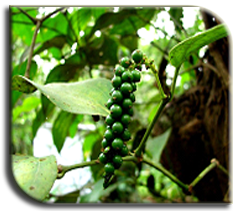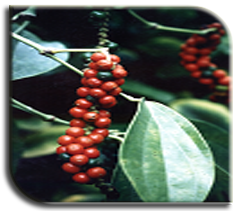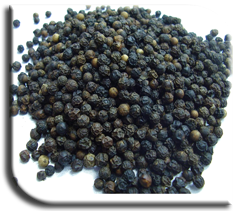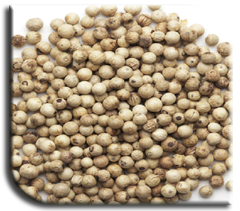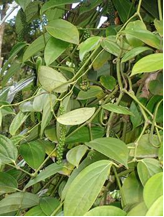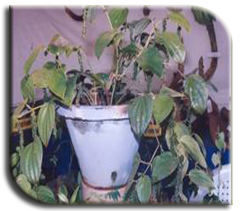
|
||||||||||||||||||||||||||||
Horticulture :: Spice Crops :: Pepper |
||||||||||||||||||||||||||||
| Black pepper (Piper nigrum L.) |
||||||||||||||||||||||||||||
| Piperaceae | Natural Farming |
|||||||||||||||||||||||||||
1. Main Stem 2. Runner Shoots 3. Fruiting branches (Plagiotropes) are produced from the nodes of the main stem and they grow laterally more or less at right angles to the main stem, bearing the spikes. 4. Topshoots (Orthotropes): After a period of vertical growth, the top portion of the main shoots attains a bushy appearance with shorter, thicker internodes and profuse branching with large number of adventitious roots at the nodes. This portion of the main shoot is called top shoots or orthotropes. 5. Hanging shoots (Geotropes): In a fully grown vine, some of the plagiotropes at the top portion are seen to give rise to a special type of shoots which hang down and grow geotropically.
Soil and climate Pepper is grown mainly as a rainfed crop. Pepper requires heavy rainfall (150 - 250 cm) high humidity and warm climate.Thrives best on virgin soils rich in humus content and the crop can be grown at elevations up to 1500 m. Season June – December Propagation Black pepper vines develop three types of aerial shoots, namely (a) primary stem with long internodes, with adventitious roots which cling to the standards (b) runner shoots which originate from the base of the vine and have long internodes which strike roots at each node and (c) fruit bearing lateral branches. Cuttings are raised mainly from runner shoots, though terminal shoots can also be used. Cuttings from lateral branches are seldom used since they develop a bushy habit. However, rooted lateral branches are useful for raising bush pepper. Production of rooted cuttings Traditional method
Rapid multiplication method An efficient propagation technique developed at Sri Lanka has been modified for adoption in India for quick and easy multiplication of black pepper vines. In this method, a trench of 45 cm depth, 30 cm width and convenient length is made. The trench is filled with rooting medium comprising of forest soil, sand and farm yard manure in 1:1:1 ratio. Split halves of bamboo with septa or split halves of PVC pipes of 1.25-1.50 meter length and 8-10 cm diameter provided with plastic septa at 30 cm intervals are fixed at 45∞ angle on a strong support. Rooted cuttings are planted in the trench at the rate of one cutting for each bamboo split. The lower portions of the bamboo splits are filled with rooting medium (preferably weathered coir dust-farm yard manure mixture in 1:1 ratio) and the growing vine is tied to the bamboo split in such a way so as to keep the nodes pressed to the rooting medium. The tying can be done with dried banana leaf sheath fibers or coir rope. The cuttings are irrigated regularly. As the cuttings grow, the bamboo splits are filled with rooting medium and each node is pressed down to the rooting medium and tied. For rapid growth, a nutrient solution of urea (1 kg), super phosphate (0.75 kg), muriate of potash (0.5 kg) and magnesium sulphate (0.25 kg) in 250 litres of water is to be applied @ 0.25 litre per vine at monthly intervals. When the vine reaches the top (3-4 months after planting of the cutting) the terminal bud is nipped off and the vine is crushed at about three nodes above the base, in order to activate the axillary buds. After about 10 days, the vine is cut at the crushed point and removed from the rooting medium and cut between each node. Each cutting with the bunch of roots intact is planted in polythene bags filled with fumigated potting mixture. Trichoderma @ one gram and VAM @ 100 cc/kg of soil can be added to the potting mixture. Care should be taken to keep the leaf axil above the soil. The polythenebags should be kept in a cool and humid place, or should be covered with thin polythene (200 gauge) sheet to retain humidity. The buds start developing in about 3 weeks and the polybags can then be removed and kept in shade.
The advantages of this method of propagation are rapid multiplication (1:40), well developed root system, higher field establishment and vigorous growth as a result of better root system. Trench method A simple, cheap and efficient technique for propagating black pepper from single nodes of runner shoots taken from field grown vines has been developed at the institute. A pit of 2.0 meter x 1.0 meter x 0.5 meter size is dug under a cool and shaded area. Single nodes of 8-10 cm length and with their leaf intact, taken from runner shoots of field grown vines are planted in polythene bags (25 cm x 15 cm, 200 gauge) filled at the lower half with a mixture of sand, soil, coir dust and cow dung in equal proportion. The single nodes are to be planted in the bags in such a way that their leaf axil is above the potting mixture. The polythene bags with the planted single nodes are arranged in the pit. After keeping the bags in the pit, the pit should be covered with a polythene sheet. This sheet may be secured in position by placing weights on the corners. The cuttings should be watered at least five times a day with a rose can and the pit should be covered with the polythene sheet immediately after watering. It is advisable to drench the cuttings two-three times with copper oxychloride (2g/litre). After two-three weeks of planting, the cuttings will start producing roots which are visible through the polythene bags. After the initiation of roots the frequency of watering may be reduced to three-four times a day. After about one month, new shoots start emerging from the leaf axil. At this stage it is advisable to keep the pit open for about one hour per day so that the cuttings would harden and will not dry when they are taken out of the pit. The cuttings can be taken out of the pit after two months of planting and kept in a shaded place and watered twice a day. These cuttings will be ready for field planting after about 2Ω months. By this method 80-85 per cent success can be obtained. Foliar application of nutrient solution will also enhance the growth of the cuttings. Serpentine method Cheaper propagation technique for production of rooted cuttings of black pepper is serpentine layering. In a nursery shed with roofing sheet or shade net, rooted black pepper cuttings are planted in polythene bags holding about 500 g potting mixture, which will serve as mother plants. As the plant grows and produces few nodes small polythene bags (20 x 10 cm) filled with potting mixture may be kept under each node. The node may be kept gently pressed in to the mixture assuring contact with the potting mixture with the help of a flexible twig such as mid rib of a coconut leaflet to enable rooting at that junction. Roots start growing from the nodes and the cuttings keep on growing further. The process of keeping potting mixture filled polythene bags at every node to induce rooting at each node is repeated. In three months the first 10 to 12 nodes (from the mother plants) would have rooted profusely and will be ready for harvest. Each node with the polythene bag is cut just below the rooted node and the cut end is also buried into the mixture to induce more roots. Polythene bags filled with solarized potting mixture or soil, granite powder and farmyard manure in 2:1:1 proportion is recommended for producing disease free rooted cuttings. The rooted nodes will produce new sprouts in a week time and will be ready for field planting in two-three months time. Daily irrigation can be given with a rose can. On an average, 60 cuttings can be harvested per mother plant in a year by this method.
Planting Slopes facing West and South should be avoided. Pits of 50 cm x 50 cm x 50 cm size are dug at a spacing of 2 to 3 m in either direction (Panniyur 1 - 3 x 3 m). 5 to 10 kg of FYM/Compost is mixed with top soil and the pits are filled. Rooted cuttings are planted in June - July @ two per standard like Silver oak, Dadap and Jack. In multitier cropping system, standards should be planted at a spacing of 7 – 8 m. Manuring Apply cattle manure or Compost @ 10 kg/vine just before the onset of South West monsoon. In addition 100 g of N, 40 g of P and 140 g of K per vine are applied in two split doses in the months of May - June and in September - October. Slaked lime at 500 g per vine is applied in alternate years during May - June.Apply Azospirillum @ 100 g/vine one month after the application of chemical fertilizers. Integrated nutrient management - Inorganic N 50 % of the recommended dose + FYM 10 kg + 50 g Azospirillum + 50 g Phosphobacteria + 200 g VAM per plant.The manures and fertilizers are applied around the vine at a distance of 30 cm from the base and incorporated into the soil. Irrigation Protective irrigation in basins during December - May at 10 days interval. Aftercultivation Two weedings are given during the months of June - July and at October - November. The vines are to be trained to the standards. Prune excessive foliage of the standards and limit the height of the standards to about 6 m. Spray NAA @ 40 ppm to increase the berry size. Fruit drop The spike shedding can be reduced by foliar spray of Diammonium Phosphate 1.0 % four times viz., before flower initiation (May), during new leaves and flower emergence (June) before spike initiation (July) and pinhead stage of berries (August). Plant protection Spray Quinalphos 25 EC 2 ml/lit once in July and again in October. Leaf gall and thrips Spraying Monocrotophos 36 WSC 1.5 ml/lit or Dimethoate 30 EC @ 2 ml/lit or Chlorpyriphos 2 ml/lit or Dichlorvos 76 WSC 1 ml/lit or Phosphomidan 40 SL @ 2 ml/lit three rounds at monthly intervals starting from new flush formation. Top shoot borer Top shoot borer can be controlled by spraying Monocrotophos or Quinalphos (0.05%) on terminal shoots at monthly intervals (during July – October) to protect emerging new shoots. Diseases Apply Trichoderma viride @ 1 g/kg of pot mixture. Mulch the pot mixture with 150 gauge polythene sheet for 30 days and inoculate with Pseudomonas. Main field Any of the following formulation can be drenched in the soil twice (May – June and October - November).
Slow wilt: Apply Phorate 10 G @ 30 g or Carbofuran 3 G @ 100g per vine (May – June and September - October) + Copper oxy Chloride @ 0.2 % (Soil drenching) or Potassium phosphonate @ 0.3% or Metalaxyl @ 0.1 %.
Harvesting and curing Pepper vines start yielding usually from the 3rd or 4th year. The vines flower in May-June. It takes 6 to 8 months from flowering to ripening stage. Harvesting is done from the November to February in the plains and January to March in the hills. When one or two berries on the spikes turn bright or red, the whole spike is plucked.
Berries are separated from the spikes by rubbing them between the hands or trampling them under the feet. After the separation, the berries are dried in the sun for 7 to 10 days until the outer skin becomes black and shrunken and assumes the characteristics wrinkled appearance of commercial black pepper. For making good quality black pepper of uniform colour, the separated berries are collected in a perforated bamboo basket or vessel and the basket with the berries is dipped in boiling water for one minute. The basket is then taken out and drained. The treated berries are sun dried on a clean bamboo mat or cement floor. Considerable advances have been made in recent years in the diversification of value and added processed products from the pepper which has great demand. They include 3 major groups viz., (a) green pepper based products canned or bottled green pepper in brines, cured green pepper, frozen green pepper, freeze dried green pepper, dehydrated green pepper, green pepper pickles, green pepper flavoured products white pepper (whole) or powder etc., (b) black pepper based products-Black pepper powder, pepper oleoresins, pepper oils etc and (c) pepper by-products which have medicinal, culinary and industrial uses. These processed products earn more foreign exchange per unit weight /volume.
Yield Market information
Bush Pepper It is a method of cultivating the vine in the form of bush. One year old healthy fruiting branches are selected with 3 to 5 nodes and all the leaves except the flag leaf are removed and planted in a shaded area in the nursery, either in trenches or in polybags (45X30 cm) containing moist coir dust. Before planting, the cuttings are dipped in 1000 ppm of IBA for 45 seconds. After planting, the trenches are covered with polythene sheets and in the case of polybags; the mouth is tightly tied with coir thread to avoid moisture loss. They normally root in 30 to 50 days. Such rooted cuttings are planted in pots or fields after sufficient hardening treatment. Cuttings grow like a bush and flower in the same year itself. These bushes produce more and more of fruiting branches only. Adequate manuring i.e., 2 to 5 kg of FYM along with 10g of NPK 1:1:2 mixtures may be given per bush at 3 months interval. Watering and plant protection may be adopted according to necessity. Under average management a good bush pepper plant may yield 1.5 kg green pepper in a span of 2 to 3 years.
Pruning: Pruning of hanging shoots to maintain the bushy nature, repeating at every two years interval. Sources: Spices Board, Kerala http://eagri.org http://www.spices.res.in https://kau.in |
||||||||||||||||||||||||||||
© All Rights Reserved. TNAU 2008-2024. |
||||||||||||||||||||||||||||

.jpg)
.jpg)
.jpg)
